Heart Rate Variability: what it is and how we can influence it
Heart on a tree via Pixabay
Alan Littlefield was one of our keynote speakers at the conference in September. He spoke about building trusting teams and introduced the concept of positively affecting our HRV by deploying the BREATHE skill, to improve both our individual and our team performance. The breathing bit, it has to be said, inspired a degree of scepticism amongst some in the audience, with a few questions raised.
From the archive: Mountain Rescue Magazine Issue 91, January 2025. On a mission to better understand the idea, Judy Whiteside and Chris Cookson did a bit of digging into what’s been published thus far on the topic, and caught up with Alan again in December to discuss those questions.
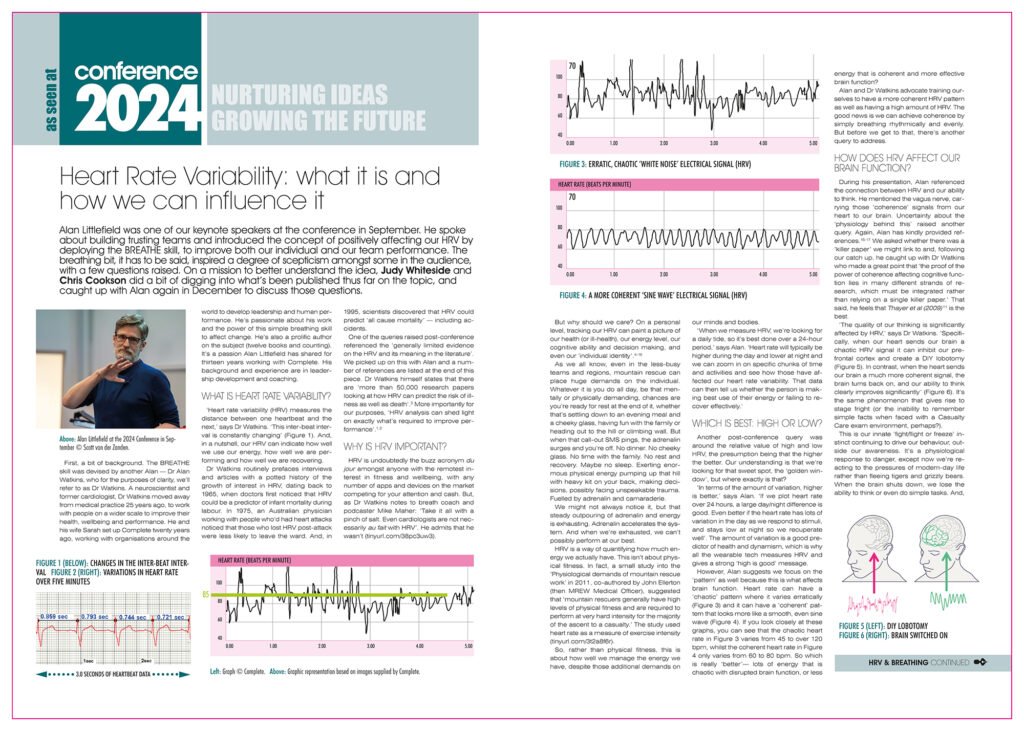
First, a bit of background. The BREATHE skill was devised by another Alan — Dr Alan Watkins, who for the purposes of clarity, we’ll refer to as Dr Watkins. A neuroscientist and former cardiologist, Dr Watkins moved away from medical practice 25 years ago, to work with people on a wider scale to improve their health, wellbeing and performance. He and his wife Sarah set up Complete twenty years ago, working with organisations around the world to develop leadership and human performance. He’s passionate about his work and the power of this simple breathing skill to affect change. He’s also a prolific author on the subject (twelve books and counting). It’s a passion Alan Littlefield has shared for thirteen years working with Complete. His background and experience are in leadership development and coaching.
What is Heart Rate Variability?
‘Heart rate variability (HRV) measures the distance between one heartbeat and the next,’ says Dr Watkins. ‘This inter-beat interval is constantly changing’ (Figure 1). And, in a nutshell, our HRV can indicate how well we use our energy, how well we are performing and how well we are recovering.
Dr Watkins routinely prefaces interviews and articles with a potted history of the growth of interest in HRV, dating back to 1965, when doctors first noticed that HRV could be a predictor of infant mortality during labour. In 1975, an Australian physician working with people who’d had heart attacks noticed that those who lost HRV post-attack were less likely to leave the ward. And, in 1995, scientists discovered that HRV could predict ‘all cause mortality’ — including accidents.
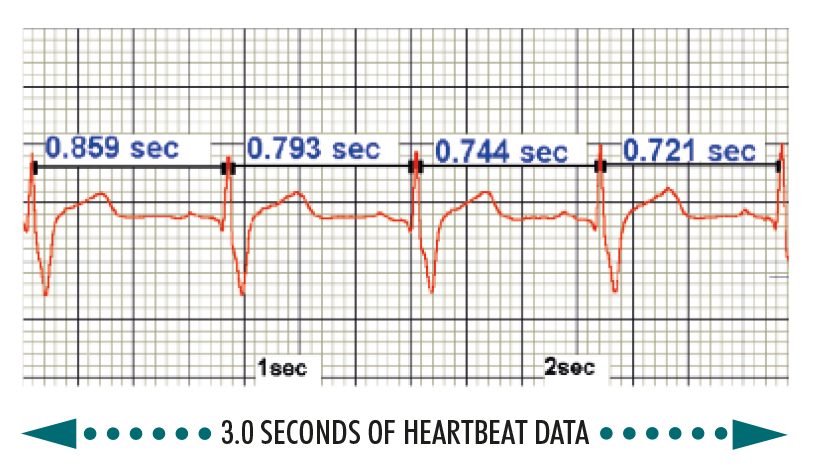
One of the queries raised post-conference referenced the ‘generally limited evidence on the HRV and its meaning in the literature’. We picked up on this with Alan and a number of references are listed at the end of this piece. Dr Watkins himself states that there are ‘more than 50,000 research papers looking at how HRV can predict the risk of illness as well as death’.3 More importantly for our purposes, ‘HRV analysis can shed light on exactly what’s required to improve performance’.1,2
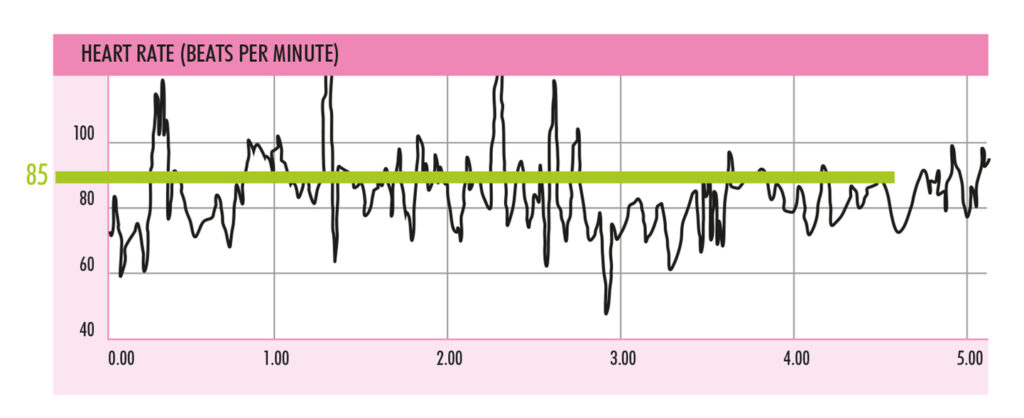
Why is HRV important?
HRV is undoubtedly the buzz acronym du jour amongst anyone with the remotest interest in fitness and wellbeing, with any number of apps and devices on the market competing for your attention and cash. But, as Dr Watkins notes to breath coach and podcaster Mike Maher: ‘Take it all with a pinch of salt. Even cardiologists are not necessarily au fait with HRV’. He admits that he wasn’t.
But why should we care? On a personal level, tracking our HRV can paint a picture of our health (or ill-health), our energy level, our cognitive ability and decision making, and even our ‘individual identity’.4-15
As we all know, even in the less-busy teams and regions, mountain rescue can place huge demands on the individual. Whatever it is you do all day, be that mentally or physically demanding, chances are you’re ready for rest at the end of it, whether that’s settling down to an evening meal and a cheeky glass, having fun with the family or heading out to the hill or climbing wall. But when that call-out SMS pings, the adrenalin surges and you’re off. No dinner. No cheeky glass. No time with the family. No rest and recovery. Maybe no sleep. Exerting enormous physical energy pumping up that hill with heavy kit on your back, making decisions, possibly facing unspeakable trauma. Fuelled by adrenalin and camaraderie.
We might not always notice it, but that steady outpouring of adrenalin and energy is exhausting. Adrenalin accelerates the system. And when we’re exhausted, we can’t possibly perform at our best.
HRV is a way of quantifying how much energy we actually have. This isn’t about physical fitness. In fact, a small study into the ‘Physiological demands of mountain rescue work’ in 2011, co-authored by John Ellerton (then MREW Medical Officer), suggested that ‘mountain rescuers generally have high levels of physical fitness and are required to perform at very hard intensity for the majority of the ascent to a casualty.’ The study used heart rate as a measure of exercise intensity.
So, rather than physical fitness, this is about how well we manage the energy we have, despite those additional demands on our minds and bodies.
‘When we measure HRV, we’re looking for a daily tide, so it’s best done over a 24-hour period,’ says Alan. ‘Heart rate will typically be higher during the day and lower at night and we can zoom in on specific chunks of time and activities and see how those have affected our heart rate variability. That data can then tell us whether the person is making best use of their energy or failing to recover effectively.’
Which is best: high or low?
Another post-conference query was around the relative value of high and low HRV, the presumption being that the higher the better. Our understanding is that we’re looking for that sweet spot, the ‘golden window’, but where exactly is that?
‘In terms of the amount of variation, higher is better,’ says Alan. ‘If we plot heart rate over 24 hours, a large day/night difference is good. Even better if the heart rate has lots of variation in the day as we respond to stimuli, and stays low at night so we recuperate well’. The amount of variation is a good predictor of health and dynamism, which is why all the wearable tech measures HRV and gives a strong ‘high is good’ message.
However, Alan suggests we focus on the ‘pattern’ as well because this is what affects brain function. Heart rate can have a ‘chaotic’ pattern where it varies erratically (Figure 3) and it can have a ‘coherent’ pattern that looks more like a smooth, even sine wave (Figure 4). If you look closely at these graphs, you can see that the chaotic heart rate in Figure 3 varies from 45 to over 120 bpm, whilst the coherent heart rate in Figure 4 only varies from 60 to 80 bpm. So which is really ‘better’— lots of energy that is chaotic with disrupted brain function, or less energy that is coherent and more effective brain function?
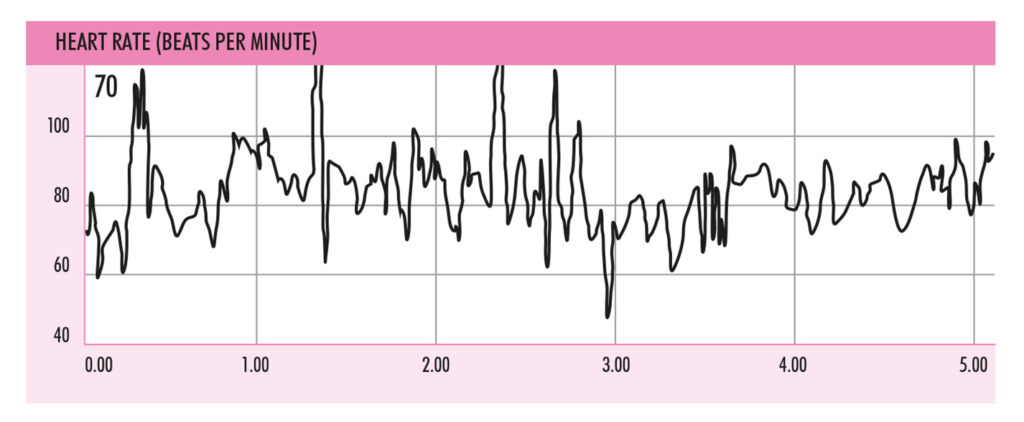
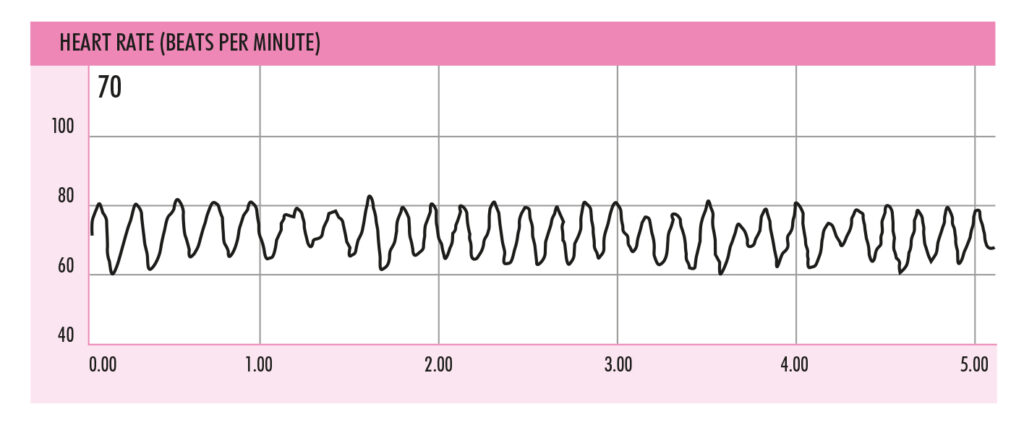
Alan and Dr Watkins advocate training ourselves to have a more coherent HRV pattern as well as having a high amount of HRV. The good news is we can achieve coherence by simply breathing rhythmically and evenly. But before we get to that, there’s another query to address.
The quality of our thinking is significantly affected by HRV. Specifically, when our heart sends our brain a chaotic HRV signal it can inhibit our prefrontal cortex and create a DIY lobotomy. In contrast, when the heart sends our brain a much more coherent signal, the brain turns back on, and our ability to think clearly improves significantly.
How does HRV affect our brain function?
During his presentation, Alan referenced the connection between HRV and our ability to think. He mentioned the vagus nerve, carrying those ‘coherence’ signals from our heart to our brain. Uncertainty about the ‘physiology behind this’ raised another query. Again, Alan has kindly provided references.16-17 We asked whether there was a ‘killer paper’ we might link to and, following our catch up, he caught up with Dr Watkins who made a great point that ‘the proof of the power of coherence affecting cognitive function lies in many different strands of research, which must be integrated rather than relying on a single killer paper.’ That said, he feels that Thayer et al (2009)11 is the best.
‘The quality of our thinking is significantly affected by HRV,’ says Dr Watkins. ‘Specifically, when our heart sends our brain a chaotic HRV signal it can inhibit our prefrontal cortex and create a DIY lobotomy (Figure 5). In contrast, when the heart sends our brain a much more coherent signal, the brain turns back on, and our ability to think clearly improves significantly’ (Figure 6). It’s the same phenomenon that gives rise to stage fright (or the inability to remember simple facts when faced with a Casualty Care exam environment, perhaps?).
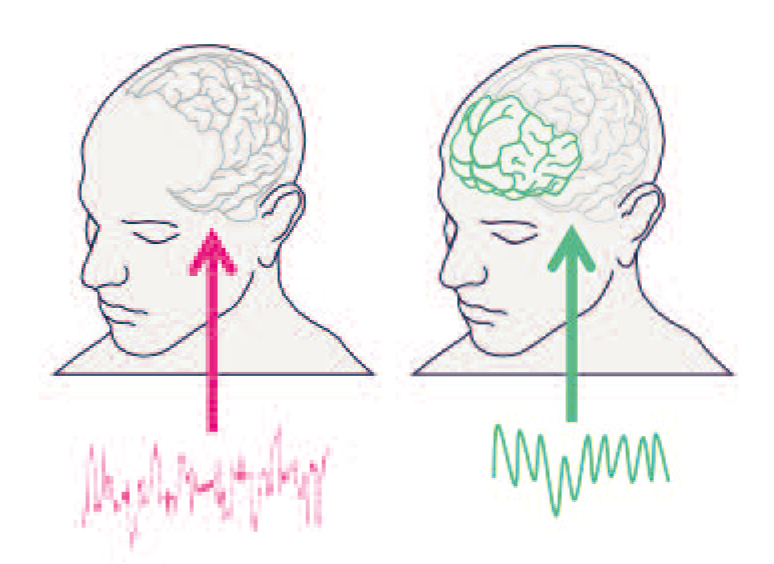
This is our innate ‘fight/flight or freeze’ instinct continuing to drive our behaviour, outside our awareness. It’s a physiological response to danger, except now we’re reacting to the pressures of modern-day life rather than fleeing tigers and grizzly bears. When the brain shuts down, we lose the ability to think or even do simple tasks. And, worse still, when our brain shuts down in this way, it also affects our perceptual awareness, so we don’t even realise we’re not performing well. We may even be thinking the exact opposite, while those around us grit their teeth in barely concealed frustration.
At the conference, Alan demonstrated this phenomenon with willing volunteer Harry, from North Dartmoor team. Connected to a monitor, via a clip on his earlobe, our volunteer’s heart rate was displayed on the screen above, for all to see. Having lulled his victim into a false sense of security with amiable chat, Alan redirected his attention, asking Harry to count backwards from 300 in steps of three, whilst also seeking to further confuse matters with random numbers and banter.
As you might expect, the heart rate graph headed sharply upwards. This too was commented on in the verbal feedback (something along the lines of ‘No surprise Sherlock!’) to which we say, yes, he was facing an audience of 200-plus people and being asked to count backwards at speed — of course he was stressed. But the idea was to demonstrate how our heart rate is affected by stress and to look at the underlying pattern of HRV, rather than how high the heart rate went, and then see how that could be calmed into a smoother sine wave by simply breathing rhythmically and evenly. Once Harry was invited to breathe in time with a rhythmically moving pacer on screen, we saw his heart rate come down and his HRV settle from chaotic into a more coherent wave form, in less than a minute. A huge thank you to him for being such a good sport!
This live demonstration is an integral piece of the many presentations and TedX Talks by Dr Watkins, available online. We recommend ‘Being Brilliant Every Single Day’, from 2012, available from Complete.
The whole idea is to practice and, by practising, perform better. The BREATHE skill is like a piece of gym equipment. If you don’t it pick up on a regular basis — and practise good form — you won’t build the muscle.
We queried whether this demo ever goes beyond the calming of the heart rate. Whether, armed with this new technique, the volunteer is ever asked to repeat the counting down exercise. Understandably perhaps, the answer is no — because it takes time and practice to establish the skill. To expect any volunteer, however mathematically brilliant, to so soon again face the stress of performing in public would be unreliable. Not to say quite cruel!
‘The whole idea is to practice and, by practising, perform better’, says Alan. ‘The BREATHE skill is like a piece of gym equipment. If you don’t it pick up on a regular basis — and practise good form — you won’t build the muscle.
‘The key is to begin by practising in simple situations, maybe on your own in a quiet moment, a minute at a time, then during a conversation where you have to both talk and listen… gradually moving onto more challenging situations. Build the muscle so you can use it when things are challenging, even in high stakes.’
Once mastered, it becomes second nature. Dr Watkins (we hear) has a favourite anecdote, which might resonate here. We ask Alan whether Complete had ever worked with other emergency services or first responders, and this story fits that bill. Dr Watkins was working with personnel at an RAF base and they decided to put his fine words to the test, in a helicopter simulator. Using the breathing skill, he was able to ‘fly the aircraft’, his HRV reflecting that he was dealing well with the pressure. However, not satisfied with this performance, his ‘captors’ decided to up the ante somewhat, with the appearance of a bunch of ‘insurgents’ aiming fire at the helicopter. Still he managed to stay ‘fairly coherent’, says Alan.
Alan has his own tale, of heading to a noisy neighbour’s house to remonstrate with him about the din. Heading to the door, he deployed the breathing skill, consciously bringing himself to a level of coherence. The door opened and his neighbour took one look at him before aiming a punch at Alan’s face — which he swerved, like a slow-mo scene from ‘The Matrix’, as the fist travelled past his ear. Stunned at the reaction, the noisy neighbour promptly went inside and turned the noise down.
So, how can we improve our HRV?
Full disclosure here: both of us — thanks to our own HRV monitoring devices — have seen in real time how the stresses of our ‘mountain rescue life’ can affect our heart rate variability, Chris as an operational team member and Judy as a non-operational keyboard warrior and serial online meeting attender. Never mind the yomping uphill, we can tell you from experience, those late night meetings, staring for hours at a screen after a long day’s work, have a demonstrable effect on that HRV chart! And not in a good way. On the other hand, we’ve also seen the beneficial effect of a focused breathing session (Figure 8).
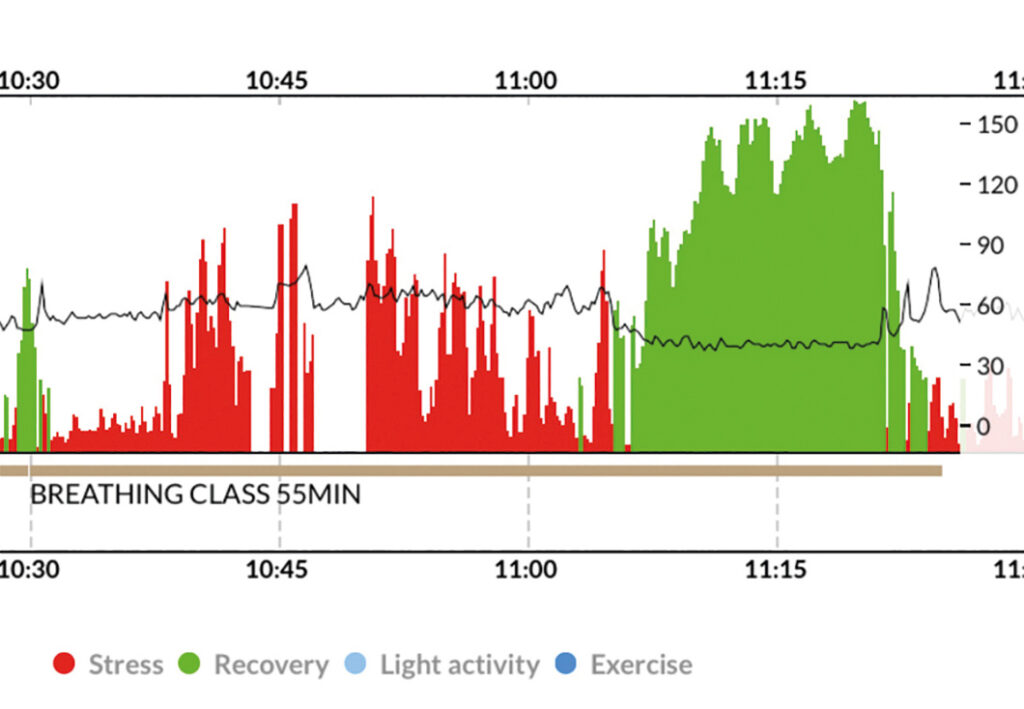
As Dr Watkins explains, we improve our HRV by ‘reducing the chaos in our system and developing more bio-coherence’. This, in turn, ‘facilitates an improvement in brain function’. Complete lists twelve dimensions to our breath which we can learn to control. The three most important to generate coherence are:
- Rhythmicity (fixing the in:out ratio)18
- Smoothness (even flow rate in and out)18
- Location of attention (focus on the heart).19
Rhythmicity: There are many theories about the optimum ratio for beneficial breathing. For example, Brown and Gerbarg and Stephen Elliott teach that a rate of five breaths per minute is ‘essential’ for ‘coherent breathing’. The world of yoga espouses any number of breathing techniques, each with a different intention, too many to detail here.
At Complete, it’s simple: it doesn’t matter what ratio you use, the main point is to maintain a consistent rhythm. If your HRV signal becomes rhythmic, ‘this can stabilise other aspects of your physiology, enabling other systems to operate with a much greater energy efficiency’.
Smoothness: ‘Bio-coherence requires a silky smooth breath’ with ‘a fixed volume of air’ going in and out of your lungs per second.18 Imagine breathing along a sine wave on a graph, or tracing your breath around the perimeter of an oval shape.
Location of attention: Fellow yogis out there will be familiar with the concept and practice of interoception — cultivating an awareness of where your body is in space, ‘listening’ to what’s going on inside, using the breath to release tension in specific areas. What Complete talks about is bringing awareness to our heart centre (imagine somewhere behind the sternum as in Figure 7, not high in the chest). Why? The heart is the powerhouse of our body, generating electrical and electromagnetic energy which extends beyond the body by some distance. Focusing here draws us away from our busy mind. And, finally, focusing on the heart can ‘facilitate positive emotional experiences’.
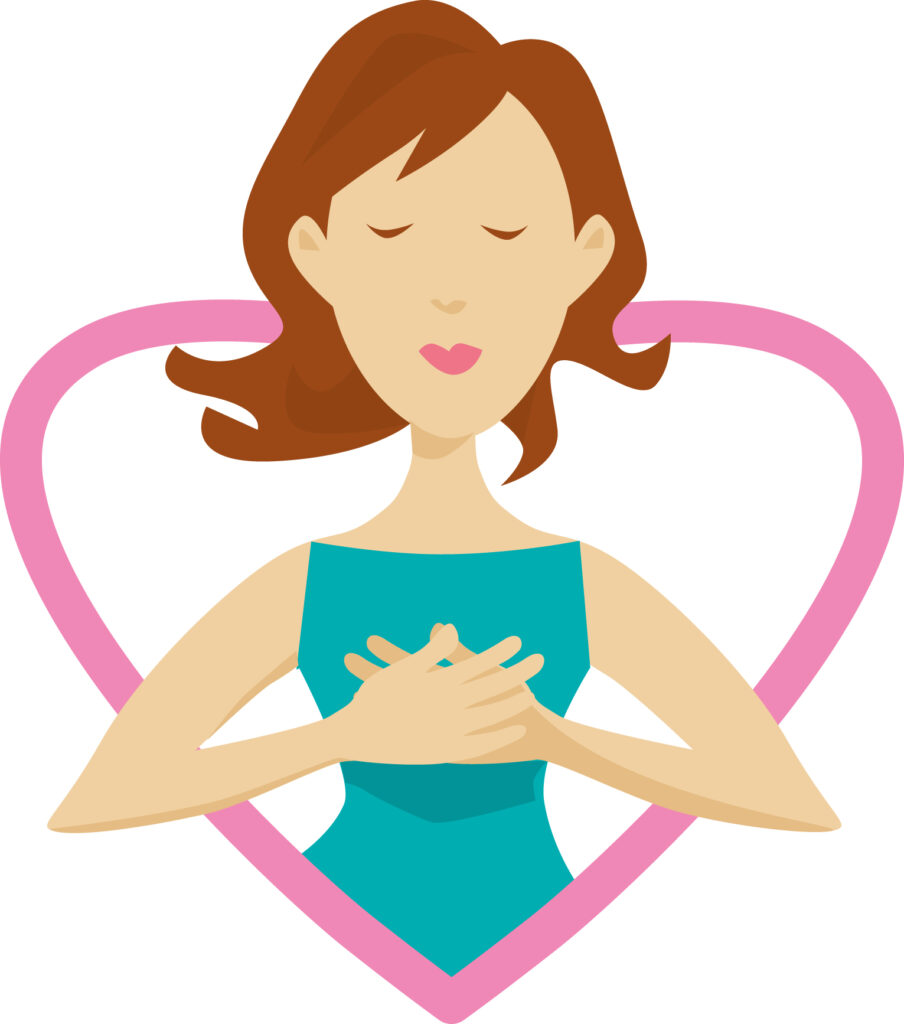
For the record, the other nine dimensions which we can learn to control are listed below. Whilst the first three above help us become coherent, the nine below have different effects on the body:
- Speed of breathing (alters arousal and adrenalin levels)
- Pattern of in and out (affects CO2 and vascular tone)
- Volume of air in a single breath (affects CO2 and vascular tone)
- Entrainment with other systems (drives system synchronisation)
- Depth of breath (impacts oxygenation)
- Resistance through the nose and mouth (affects humidification and has an antibacterial effect)
- Flow patterns around the body (helps regulate attention control)
- Special techniques (such as Vipassana, Buteyko, Nadi Shodana etc)
- Mechanics of accessory muscles (alters energy expenditure).
So what is this BREATHE skill?
The acronym BREATHE invites us to Breathe Rhythmically Evenly And Through the Heart Every day.
Of course, we’re all breathing all the time (until we’re not), and this is often cited as a reason not to bother practising anything other than just getting on with it — ‘I already know how to breathe’, a well-worn refrain. Usually delivered with some semblance of smirk. But, for all the reasons noted, learning to breathe coherently, and doing this more often, has the power to transform your life. Dr Watkins even maintains that breathing regularly with coherence can ‘turn the clock back ten years’ on your energy levels, so why wouldn’t you try it?
Complete top tips for practising the BREATHE skill:
- 10 by 10 Challenge: Practise for a minute on Day 1, then increase by one minute a day for ten days.
- Countdown Challenge: Set a target time on your phone. Each time you have the opportunity to do some coherent breathing, start the timer, then pause again when you stop. Aim to get the clock to zero within a week.
- Handy Habits: Attach breathing practice to everyday habits such as queuing for coffee, listening to the news, sitting in a traffic jam.
- Performance Enhancer: Anticipate difficult situations with a five-minute practice before hand (as per the noisy neighbour tale).
- And a few more from us: Download a breathing app, find a suitably rhythmic piece of music, set a metronome, come along to Judy’s yoga classes… whatever works for you, but start small and keep practising.
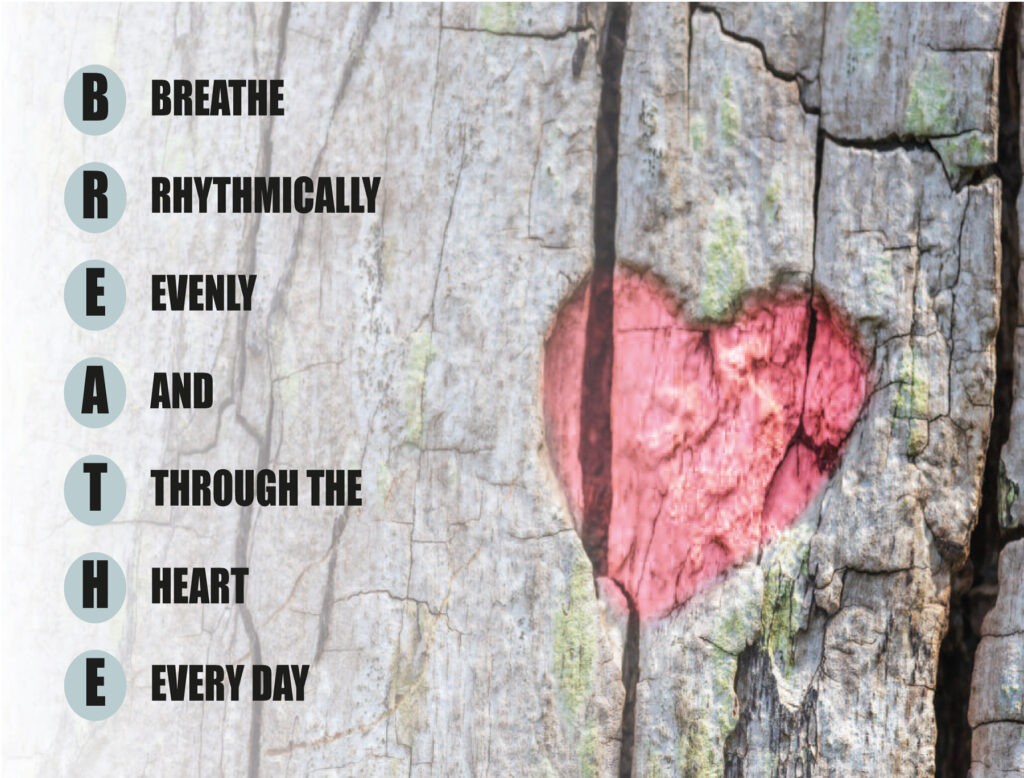
Why is this relevant to you as a team?
Okay, we sense there might still be some resistance to the idea that simply breathing more coherently can change — well, anything. But remember that breathing coherently improves brain function and means ‘less cortisol in your system, more energy and more helpful emotions’ — arguably ALL essential qualities in a mountain rescue environment. And then there’s entrainment — not just the entrainment of an individual’s bodily systems, where your bio-oscillators are sufficiently synchronised to create a ‘flow state’, but the entrainment of an entire team, working together in perfect harmony.
In an ideal world, no matter the individuals and personalities involved in any one call-out, when the chips are down, things just flow. Everyone knows what they’re doing, everything falls into place, everyone gets on. This is entrainment. ‘Good examples of entrainment might be a starling murmuration or a Mexican wave,’ says Alan. ‘Nobody really knows where it begins, but everyone there is perfectly attuned to what’s happening.’
But this isn’t an ideal world and maybe sometimes things don’t flow quite as well as we’d like. In the high stakes of a call-out, team members might be most exposed to that moment of brain shutdown. That ‘What do I do now?’ moment.
People can get ‘task fixated’ too, unable to see the bigger picture. When you’re coherent, you can still focus on a task, but be aware of everything else around at the same time. So we’re not advocating having a group ‘breathe-in’ before every incident or training session (we know how far THAT one would fly), but perhaps encourage individuals to become more coherent. Even increasing awareness a small amount individually could create a collective improvement.
And, it may not surprise you to hear that the most important person in the process of entrainment is whoever is leading the team or group — be that the ‘team leader’ in name or whoever is making the decisions on the day. If that person is coherent, their coherence will influence everyone around them thanks to the electrical and electromagnetic signals their heart gives out.
This concept of entrainment was first recognised in 1665, when the Dutch physicist Christian Huygens discovered that the pendulum frequencies of two clocks became synchronised to each other. After much experimentation, he concluded that a feedback loop drives ‘an adjustment process in which different energy amounts are gradually eliminated to zero until both moving bodies move in resonant frequency or synchrony.
Put simply, team members are no more than a collection of oscillating bodies, entraining themselves to the strongest amongst them, so it’s important that the strongest oscillator is getting it right!
Anything else Complete would recommend?
There’s an app, of course. It’s packed with ‘advice and skills as well as software to track your own biology’. Just search for the ‘Complete App’. And the two devices that Alan recommends work well with the app are the Kyto KYTO2935 ear clip and the Polar H10 chest strap.
That said, you don’t need an app to start practising coherent breathing. Just do it. Your body and brain — and, indirectly, your fellow team members and the casualties you rescue — will thank you for it.
References
1: Thayer JF, Yamamoto SS & Brosschot JF (2010). The relationship of autonomic imbalance, heart rate variability and cardiovascular disease risk factors. International Journal of Cardiology, 141(2), 122–131. 2: Watkins A. Coherence. The Science of Exceptional Leadership. 2nd edition (2021). Kogan Press, London 2021. 3: Tiwari R, Kumar R, Malik S, Raj T & Kumar P. Analysis of Heart Rate Variability and Implication of Different Factors on Heart Rate Variability Curr Cardiol Rev. 2021; 17(5). 4: Heiss S, Vaschillo B, Vaschillo EG, Timko CA & Hormes JM. Heart rate variability as a biobehavioral marker of diverse psychopathologies: A review and argument for an ‘ideal range’. Neurosci Biobehav Rev. 2021 Feb;121:144-155. 5: Magnon V, Vallet GT, Benson A, Mermillod M, Chausse P, Lacroix A, Bouillon-Minois JB & Dutheil F. Does heart rate variability predict better executive functioning? A systematic review and meta-analysis. Cortex. 2022 Oct;155:218-236. 6: Wulsin, LR, Horn PS, Perry JL, Massaro JM & D’Agostino RB (2015). Autonomic Imbalance as a Predictor of Metabolic Risks, Cardiovascular Disease, Diabetes, and Mortality. The Journal of Clinical Endocrinology and Metabolism, 100(6), 2443–8. 7: Hajj-Boutros G, Landry-Duval MA, Comtois AS, Gouspillou G & Karelis AD. Wrist-worn devices for the measurement of heart rate and energy expenditure: A validation study for the Apple Watch 6, Polar Vantage V and Fitbit Sense. Eur J Sport Sci. 2022 Jan 31:1-13. 8: Parker SL, Sonnentag S, Jimmieson NL & Newton CJ. Relaxation during the evening and next-morning energy: The role of hassles, uplifts and heart rate variability during work. J Occup Health Psychol. 2020 Apr;25(2):83-98. 9: Forte G, Morelli M & Casagrande M. Heart Rate Variability and Decision-Making: Autonomic Responses in Making Decisions. Brain Sci. 2021 Feb 15;11(2):243. 10: Moccia L, Quintigliano M, Janiri D, De Martin V, Rogier G, Sani G, Janiri L, Velotti P, Gallese V, Speranza AM, Di Nicola M. Heart rate variability and interoceptive accuracy predict impaired decision-making in Gambling Disorder. J Behav Addict. 2021 Sep 28;10(3):701- 710. 11: Thayer JF, Hansen AL, Saus-Rose E & Johnsen BH (2009). Heart rate variability, prefrontal neural function and cognitive performance: The neurovisceral integration perspective on self-regulation, adaptation and health. 12: Annals of Behavioral Medicine, 37(2), 141–153. Bechara A & Damasio AR (2005). The somatic marker hypothesis: A neural theory of economic decision. Games and Economic Behavior, 52(2), 336–372. 13: Hjortskov N, Rissen D, Blangsted AK, Fallentin N, Lundberg U & Sogaard K (2004). The effect of mental stress on heart rate variability and blood pressure during computer work. European Journal of Applied Physiology, 92(1-2), 84–89. 14: Critchley HD (2005). Neural mechanisms of autonomic, affective and cognitive integration. Journal of Comparative Neurology, 493(1), 154–166. 15: Critchley HD, Mathias CJ & Dolan RJ (2001). Neuroanatomical basis for first- and second-order representations of bodily states, 207–212. 16: Park G, & Thayer JF (2014). From the heart to the mind: cardiac vagal tone modulates top-down and bottom-up visual perception and attention to emotional stimuli. Frontiers in Psychology, 5(May), 1–8. 17: Held J, Vîslă A, Wolfer C, Messerli-Bürgy N, Flückiger C. Heart rate variability change during a stressful cognitive task in individuals with anxiety and control participants. BMC Psychol. 2021 Mar 17;9(1):44. 18: McCraty R & Zayas MA (2014). Cardiac coherence, self-regulation, autonomic stability and psychological well-being. Frontiers in psychology, 5, 1090. 19: Ekerholt K & Bergland A (2008). Breathing: a sign of life and a unique area for reflection and action. Physical therapy, 88(7), 832-840.
And a few more, from Pub Med…
– Practice effects of a breathing technique on pilots’ cognitive and stress associated heart rate variability during flight operations.
– Cardiac coherence and post-traumatic stress disorder in combat veterans.
– Dynamics of EEG Alpha-Activity and Heart Rate Variability in Subjects Performing Cognitive Tests.
– The connection between heart rate variability (HRV), neurological health, and cognition: A literature review.
Article written with huge thanks to Alan Littlefield and Dr Alan Watkins for their input and subsequent checking, and for sharing the articles, presentations and references. We hope this has in some way answered the various queries raised at the conference. Graphic representations of Heart Rate and HRV charts used in Figures 2, 3 and 4 are based on images in ‘Coherence. The Science of Exceptional Leadership and Performance’, 2nd edition, by Dr Alan Watkins. Published by Kogan Page Limited ISBN: 978-1-3986-0118-5. For more about Complete, go to complete-coherence.com